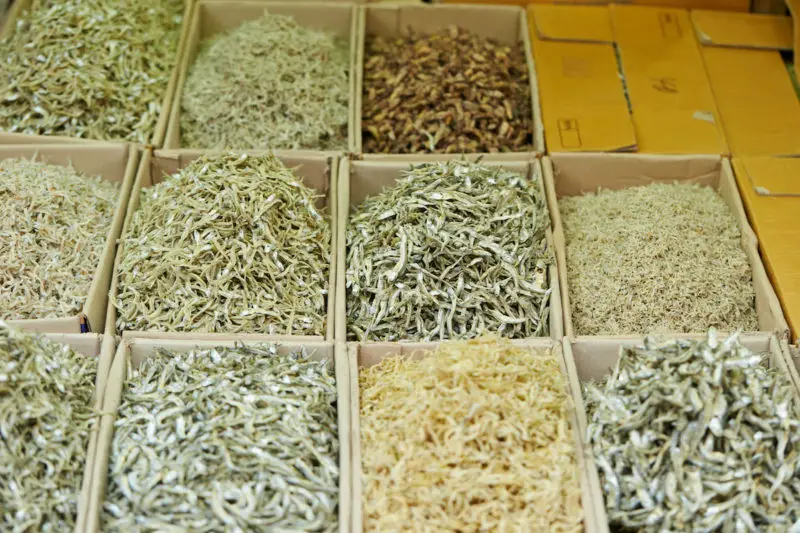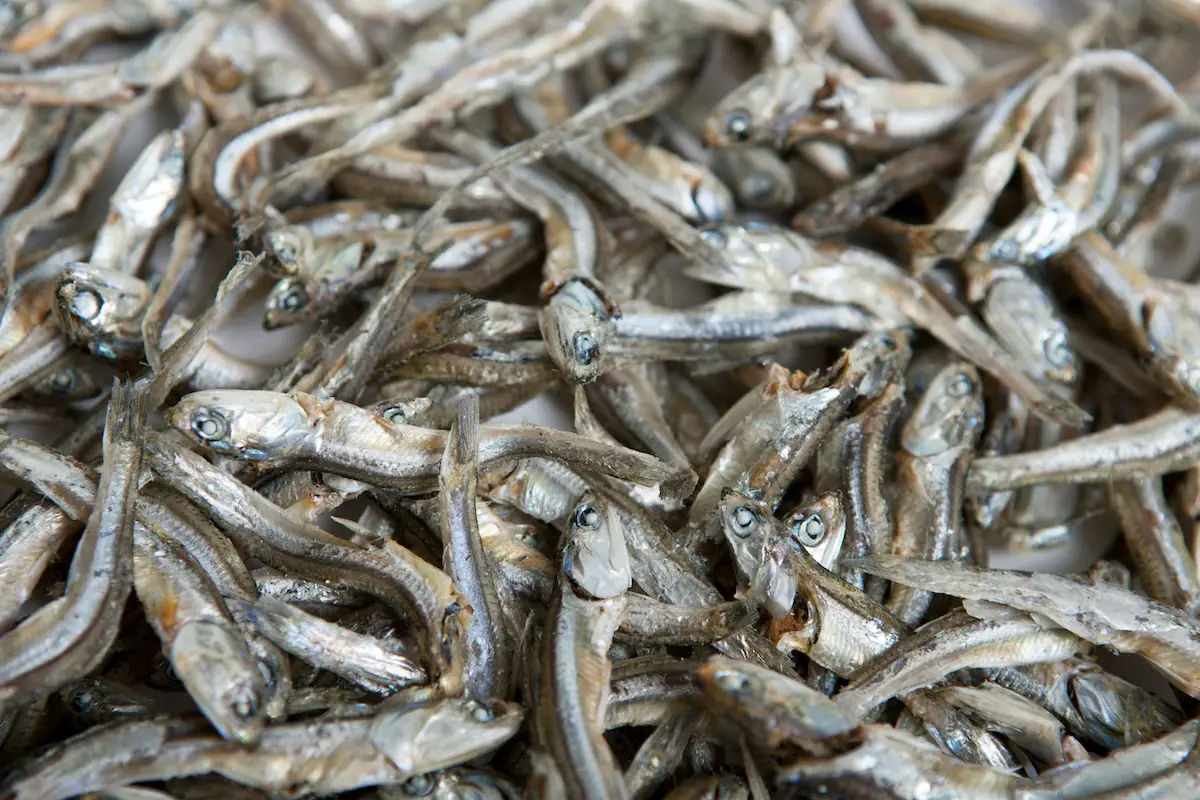This post may contain affiliate links. Please read my disclosure for details at the bottom of this page. As an Amazon Associate, I earn from qualifying purchases on this article about dried anchovies in Korean cooking. I hope you enjoy learning about myeolchi or mareun myeolchi!
Walking around the grocery store, you may have seen canned anchovies sitting next to the canned tuna and salmon, but have you ever used them? If you have cooked with canned anchovies, have you ever heard of using dried anchovies as an ingredient?
In much of East Asia, including South Korea, people prepare anchovies by sun-drying or steaming and dehydrating them. In South Korea, this dried ingredient is used as a base for many of the most traditional and popular dishes in the country. Here, we will learn about this ingredient and how it is used!
What Is Myeolchi?
Anchovies are small, saltwater bait fish that are used as human food and bait to catch other larger fish. Currently, we know of 144 species of these tiny oily fish. In South Korea, people consume these fish in three ways: fresh, dried, and made into anchovy fish sauce. Here, we will learn about dried anchovies. (You can read and learn about anchovy sauce in our ingredient article on the subject!)
‘Myeolchi’ (멸치) or’ mareun-myeolchi’ (마른멸치), otherwise known as dried anchovy in English, is an ingredient used to make bokkeum and broth in South Korea.
Once caught, people in Korea either prepare the anchovies by salting and fermenting them to make anchovy sauce, or people steam and dry them to make mareun myeolchi (dried anchovies).
Types of Myeolchi:
When sold commercially, brands separate myeolchi into different categories based on the size of the fish. They are as follows:
- Saemyeolchi (세멸치): Extra small anchovies
- Jamyeolchi (자멸치): Small anchovies
- Somyeolchi (소멸치): Medium anchovies
- Jungmyeolchi (중멸치): Large anchovies
- Daemyeolchi (대멸치): Extra large anchovies
Note: For the larger anchovies, you need to remove the head and guts before consuming or using as an ingredient in a dish.
Dried Anchovies in Korean Cuisine:
As stated above, in South Korea, people refer to dried anchovies as ‘myeolchi’ (매실청) or mareun-myeolchi (마른멸치). Below, I list a few well-known dishes that often include this umami-enhancing ingredient:
- Dashima Myeolchi Yuksu (다시마 멸치 육수): Korean-style dried kelp and dried anchovy stock. I recommend using the larger myeolchi (such as jungmyeolchi or daemyeolchi listed above) for stocks. Broths and stocks are the base for many traditional noodle dishes and soups.
- Myeolchi Bokkeum (멸치볶음): In English, this popular Korean side dish is known as stir-fried dried anchovies. People tend to use the smaller varieties of myeolchi for this dish (such as jamyeolchi or somyeolchi listed above).
Finally, people also use this ingredient as a drinking snack. In the Korean language, a ‘drinking snack’ or a ‘food consumed with alcohol’ is known as ‘anju’ (안주). People often dip the larger dried anchovies in gochujang or other sauces while drinking soju.

Dried Anchovies Frequently Asked Questions:
Now that we learned about myeolchi in Korean cuisine, I want to answer some questions you may have about this ingredient! If I do not answer your question, feel free to leave a comment in the section below or email me at [email protected].
What Do Dried Anchovies Taste Like?
Dried anchovies taste overwhelmingly of the sea. The combined fishiness and saltiness give a large umami punch when added as an ingredient.
Where Can I Buy This Ingredient?
When shopping for this ingredient, I recommend visiting your local Asian grocery store. That way, you can check the quality of the dried anchovies before buying them!
You can also find this ingredient online via stores such as Amazon! Unfortunately, when buying online, you cannot check the quality of the dried fish. Honestly, I find this to be a gamble!
How Do I Properly Store This Ingredient?
Once opened, I recommend placing dried anchovies in the refrigerator so they remain fresh. You can also store them in the freezer for a much longer period!
How Do I Know if These Dried Fish Are Good or Bad?
When looking at the dried anchovies, you first need to look at the skin and scales. You want the myeolchi to still have their silver, blue scale colors rather than scales that look dull and yellow for best quality and freshness.
Unfortunately, outside of Korea, it may be difficult to find fresh dried anchovies. Instead, you will probably find some that are dryer, more brittle, and yellower in color. This is to be expected but they are still good to eat as long as there is no mold, they have not gone past expiration, and they still taste delicious.
What Is a Good Dried Anchovy Substitute?
If you cannot find dried anchovies, you may have better luck locating Japanese bonito flakes. In Japan, people make Bonito flakes by drying skipjack tuna and shaving it into wafer-thin flakes. Then, they use the flakes as a fishy, umami ingredient when making stocks like dashi. While definitely not an exact substitute, it can help you on your way to making delicious sea-tasting stocks and broths.
Further, if you do not want to make broth fully from scratch, you can order Korean anchovy-based broth cubes that you can plop into water. Saves a lot of time and energy but it doesn’t taste as good as the homemade version! I personally love the one I link here!
I Hope You Enjoyed Learning About Myeolchi (Dried Anchovies)!
In the end, I hope you enjoyed learning about the myeolchi, otherwise known as Korean dried anchovies! If so, let us know in the comment section!
If you would like to read more about cooking, you can find recipes as well as further Korean ingredient articles on our blog. I listed some of our favorite Carving A Journey Korean recipes below! For reference, many recipes are influenced by my family’s blended Korean and Southern heritage.
Korean Ingredient Articles:
- Nuruk (Traditional Korean Starter Culture)
- Korean Green Plum Extract (Maesil Cheong)
- Baechu (Napa Cabbage) in Korean Cuisine
- What are Perilla Leaves (Kkaennip)?; And
- Gochugaru (Korean Pepper Powder)
Further Carving A Journey Recipes:
- Korean Sweet Potato Latte (Goguma Latte)
- Greek Momo Recipe (Korean Breakfast Trend); And
- Tteokkochi (Korean Rice Cake Skewers)
If you have any questions or comments, you can also email me at [email protected]. And, finally, I would love to hear from you through social media as well! You can follow me at @carvingajourney on Instagram, Facebook, and Pinterest. I also started a vlog Youtube channel! Or, if you would like more articles like these, you can subscribe to my blog by joining the mailing list. Let me know if you try cooking with dried anchovies! Thank you so much for stopping by!
Carving A Journey is a participant in the Amazon Services LLC Associates Program, an affiliate advertising program designed to provide a means for sites to earn advertising fees by advertising and linking to Amazon.com. Although we may earn commissions for our endorsement, recommendation, testimonial, and/or link to any products or services from this website, these opinions are my own and I fully support these products.

